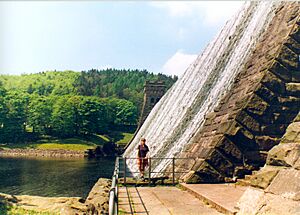Upper Derwent Valley facts for kids
The Upper Derwent Valley is a beautiful area in the Peak District National Park in England. It's mostly in Derbyshire, but a small part is in Sheffield, South Yorkshire. This valley is famous for its three large reservoirs: Ladybower Reservoir, Derwent Reservoir, and Howden Reservoir. These reservoirs were created by building big dams across the River Derwent.
Contents
Building the Dams: A Look Back
In 1899, a group called the Derwent Valley Water Board was formed. Their job was to make sure cities like Derby, Leicester, Nottingham, and Sheffield had enough water. To do this, they built two large dams in a Gothic style. These dams created Howden Reservoir in 1912 and Derwent Reservoir in 1916.
A temporary village, known as 'Tin Town', was built for the workers who constructed the dams. These workers, called 'navvies', often came with their families from places like the Elan Valley in Wales. One building from 'Tin Town' was saved and moved to Hope.
A special railway was built to carry materials for the dams. It connected the Water Board offices in Bamford to the work sites. Today, parts of this railway track are footpaths. Other sections can be seen when the water levels in the reservoirs are low. The old railway engine house is gone, and the offices are now used by a Quaker group.
Over the years, more and more water was needed. Water was brought from the River Ashop and River Alport to feed into Derwent Reservoir. But soon, even more water was required. The much larger Ladybower Reservoir was built, mostly during World War II.
Villages Under Water
Building Ladybower Reservoir meant that two villages, Derwent and Ashopton, had to be flooded. The people living there moved to a new area called Yorkshire Bridge. A historic packhorse bridge also had to be moved. It was rebuilt at Slippery Stones, north of Howden Reservoir. Even the bodies from the churchyard were carefully moved and reburied in Bamford. Ladybower Reservoir was finished in 1945.
The Dam Busters Practice
The Upper Derwent Valley looks a lot like the Ruhr Valley in Germany. Because of this, the dams here were used for practice by the famous 617 Squadron in 1943. These were the pilots of the Lancaster bombers who carried out Operation Chastise, also known as the "Dam Busters" raid. They practiced flying low over the reservoirs before their attack on the German dams. The movie The Dam Busters was later filmed at the Derwent Dams. Sometimes, you can still see special planes fly over the area to remember this history.
Water for Cities
The reservoirs in the Upper Derwent Valley are very big. They cover about 198.5 square kilometers and can hold over 463 billion liters of water! The main city that gets water from here is Sheffield, which is less than 15 kilometers away. But the reservoirs are also connected to a larger water network that reaches places as far as mid-Wales and Gloucestershire.
Originally, the reservoirs were meant to supply water to Sheffield, Derby, Leicester, and Nottingham. Sheffield received "raw" water, which means it was treated in their own plants. The other cities received water that had already been treated. Water treatment used to happen at the Yorkshire Bridge works, which are now apartments. The much larger Bamford Filter works were expanded in the 1960s and still treat water today.
Nature and Fun in the Valley
The Upper Derwent Valley is a great place for nature lovers. You might spot rare birds like black grouse and goshawk here. Much of the land around the reservoirs is looked after by the National Trust. It's a very popular spot for people who enjoy walking and cycling.


